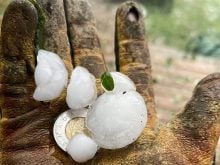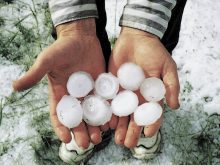A hailstorm that set a record for the largest hailstone ever found in Canada brought one of Alberta’s busiest highways to a halt northeast of Innisfail last week as it levelled crops and damaged farmhouses in Red Deer County.
It knocked out windshields and set off airbags in vehicles travelling on Highway 2 near Antler Hill at about 6 p.m. Aug. 1, said Gary Leith, manager of fire and protective services for Innisfail.
“There were approximately 50 to 70 vehicles that were severely damaged by large hailstones around baseball size in that area — basically, significant damage to the vehicles and I would suggest most of them were written off.”
Read Also

Canola oil transloading facility opens
DP World just opened its new canola oil transload facility at the Port of Vancouver. It can ship one million tonnes of the commodity per year.
A hailstone collected by Western University’s Northern Hail Project had a maximum diameter of 12.3 centimetres, which is slightly larger than a standard DVD disc. It was found near Markerville northwest of Innisfail and it weighed 292.71 grams, breaking a nearly 50-year-old record of 290 grams set in 1973 in Cedoux, Sask., said project field co-ordinator Francis Lavigne-Theriault.
It is one of only 22 hailstones around the world that have been found to be larger than 290 grams, said a university statement.
The storm’s clouds were seeded by a private company, said Lavigne-Theriault.
Such efforts are typically made using silver iodide released from aircraft to reduce the size of hail. However, he said the effectiveness of such practices is outside the scope of the Northern Hail Project.
The hailstorm was part of a supercell thunderstorm that developed in the foothills just north of Caroline, Alta., said meteorologist Kyle Fougere of Environment and Climate Change Canada. The system impacted multiple communities as it moved east into Saskatchewan, he said.
It included tennis-ball-sized hail in the Penhold, Sylvan Lake and Wimborne areas of Alberta, as well as baseball-sized hail in the Milnerton area, hen egg-sized hail in the Condor area and golfball-sized hail in the Pine Lake area.
Three collisions were reported between vehicles on Highway 2 due to hail near Antler Hill, said Cpl. Gina Slaney, media relations officer for the Southern Alberta District of the RCMP. Only minor injuries caused by the hail were reported, she said.
Three were “a little bit more serious,” she said. “One male received a cut to the underside of his neck, one female suffered from a panic attack and another male suffered from shock as a result of the incident.”
Emergency services at the scene included firefighters from Innisfail as well as EMS and officers from the town’s RCMP detachment.
“And our priority was to move those who were able to be moved off the highway to safer structures in town because the vehicles were not drivable,” said Leith.
Most of the damage in Innisfail was caused by strong winds, with trees as large as 30 centimetres in diameter snapped in half or uprooted, he said. Although there were power outages due to downed electrical lines, service was restored relatively quickly, he added.
However, farms north of the town received significant hail damage involving broken windows and siding on homes as well as damaged vehicles.
Producers have up to 14 days from the storm to submit claims for crop damage to the Agriculture Financial Services Corp., said George Kueber, provincial adjusting manager for Alberta. Although he did not have a total figure earlier this month, numerous claims had already been received, with the total cost expected to be well into the millions of dollars.
The hailstorm caused extensive damage to crops in Red Deer County.
“Corn that was standing six or seven feet tall is now a foot or two tall, so it’s been pretty much shredded,” said Cody McIntosh, agricultural services manager for the county.
Affected crops ranged from canola to peas, potentially impacting hundreds of producers, he said.
“Even some of the pastureland that we had that was coming back with forages that would have been near thigh high are now ankle high.”
Hay crops that had suffered due to dry conditions this spring had rebounded due to rain, he said. “And while that vegetation moisture is still there, the crop isn’t standing anymore and now it’s flat.”
















